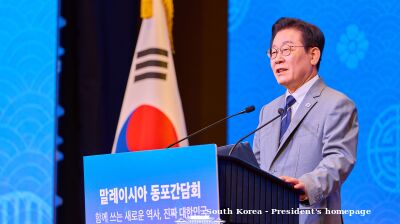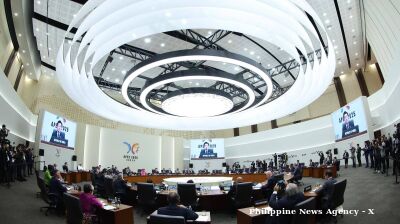On May 17, Taiwan will shut down its final operating nuclear power reactor at the Maanshan nuclear power plant in southern Taiwan. In doing so, the government of President William Lai is making a grave error in judgement — not just from an energy security standpoint, but also from an environmental and geopolitical perspective.
The decision is not entirely unexpected. Taiwan’s government committed to a nuclear phase-out back in 2014, setting a course that many celebrated as a victory for environmental and anti-nuclear campaigners. At the time, the Fukushima nuclear disaster in Japan was a recent memory, but what was once seen as an idealistic goal now looks increasingly reckless, even dangerous. Taiwan is playing with fire — quite literally — as it dismantles the only energy source that is low-carbon, reliable, and domestically truly operable at scale.
The end of nuclear power in Taiwan is not the beginning of a green utopia. It is, instead, an open invitation to higher carbon emissions, more dependence on fossil fuels, and increased exposure to geopolitical risks.
A fragile grid
Taiwan's energy grid is already under strain. Summer blackouts are relatively common, and the island's rapid industrial growth — particularly in high-tech sectors like semiconductor manufacturing and the hosting of data centres is driving up electricity demand. Taiwan’s economy, advanced and globally integrated, depends on a constant and stable electricity supply. A few hours of outage in a Taiwan Semiconductor Manufacturing Company (TSMC) fabrication plant would not merely be a domestic inconvenience; it would send ripples through global supply chains, affecting everything from cars to smartphones.
Yet, with nuclear phased out, Taiwan’s baseload generation will lean even more heavily on natural gas and coal – numbers already hovering around 42% for natural gas and in excess of 39% for coal . This isn’t just a logistical headache; it’s a strategic vulnerability.
Over 98% of Taiwan’s energy is imported. That means any disruption in maritime supply chains — whether due to conflict with China, extreme weather in the form of typhoons, or economic instability — could bring the country to a standstill.
Nuclear power, by contrast, offers energy security. A single reactor can store fuel for between 18 and 24 months. The same cannot be said for LNG, which must be imported regularly through a very limited number of terminals on the main island of Taiwan, none of which are invulnerable.
The carbon question
Supporters of the phase-out often tout Taiwan’s commitment to net-zero by 2050. Yet without nuclear power, that pathway becomes exponentially harder. In 2016, nuclear accounted for over 10% of Taiwan’s electricity generation. Removing it from the grid means something else must take its place — and at present, that “something” is primarily LNG. And while wind and solar are being deployed at scale around Taiwan, they remain intermittent.
Taiwan’s geography — a mountainous island home to 268 peaks over 3,000m and with frequent typhoons and earthquakes — presents serious constraints on renewable deployment and grid integration, particularly on the eastern seaboard and in the mountainous centre of the island. Battery storage can help, and while progress has been made in large-scale tests, it is still nowhere near the maturity or scale needed to displace firm power sources.
As a result, more fossil fuels are needed to bridge the gap until renewables are ready to bear the brunt of the capacity required by a population of around 24mn.
Meanwhile, Taiwan’s government insists that renewables will fill the gap. In late April the nation's Premier Cho Jung-tai said to the local media that there would be enough power generation to see Taiwan through to 2032.
Politics over physics
The anti-nuclear movement in Taiwan is rooted in deep historical trauma. The Fukushima disaster in Japan resonated strongly across the country given Taiwan’s own seismic risks. Public opinion turned decisively against nuclear energy, and politicians followed suit as public fear was at times stoked to political ends. But policy cannot be based on fear alone.
Modern reactors, even the older versions Taiwan has run in the past have operated with a strong safety record. The real risk lies not in operating well-regulated nuclear power stations, but in blackouts, increased air pollution, and imported fossil fuel dependency.
It is telling that while Taiwan retreats from nuclear use, Japan has restarted many of its nuclear reactors, recognising their role in energy security and climate targets. South Korea in recent years has also reinstated nuclear as a core component of its energy strategy and across the Taiwan Strait, China is building more nuclear reactors than the rest of the world combined.
Taiwan, by contrast, is marching backwards — alone and increasingly exposed.
Geopolitical blindness
Taiwan’s energy policy does not exist in a vacuum, however. The island exists under constant geopolitical pressure from China. Any future conflict across the Taiwan Strait would almost certainly involve naval blockades or attacks on critical infrastructure.
In such a scenario, nuclear power would offer a key advantage: fuel resilience. Limited uranium can provide years of energy. By removing this capability, Taiwan as an island dependent on sea lanes being clear to facilitate coal and LNG deliveries is heightening its wartime vulnerability.
A country under threat must think carefully about how it powers its economy and defends its society. Unfortunately, that calculus appears absent from Taiwan’s current government policy under the ruling Democratic Progressive Party (DPP).
What’s more, increased reliance on LNG imports will deepen ties with states like Qatar, Australia, and likely the United States with Taipei keen to be involved in the Alaska LNG project. While not necessarily problematic in itself, this approach introduces a level of diplomatic entanglement that Taiwan — already diplomatically constrained — may struggle to manage effectively.
A path not yet closed
There is still time to reconsider though, even with May 17 just three days away. The phase-out of nuclear power was never written into Taiwan’s constitution. Public opinion, once firmly anti-nuclear, is shifting as awareness of many of the aforementioned points increases, particularly among younger generations concerned about climate change.
Indeed, the decommissioning of the last reactor on Saturday, May 17 could become a symbolic moment — not of closure, but of reflection.
If the summer brings more blackouts as is likely, and if emissions continue to rise and the renewable rollout falls behind schedule again …. then perhaps Taiwan’s policymakers will look again at nuclear, not as a relic of the past, but as a pillar of a secure and sustainable future.
Nuclear power is not without risk or cost. But every energy choice involves trade-offs. The question is which risks the Taiwanese people are willing to accept, and whether the risks of living without nuclear power are greater than the ones feared by using it.
In Taiwan’s case, the answer seems increasingly clear.
Opinion

COMMENT: Czechia economy powering ahead, Hungary’s economy stalls
Early third-quarter GDP figures from Central Europe point to a growing divergence between the region’s two largest economies outside Poland, with Czechia accelerating its recovery while Hungary continues to struggle.

COMMENT: EU's LNG import ban won’t break Russia, but it will render the sector’s further growth fiendishly hard
The European Union’s nineteenth sanctions package against Russia marks a pivotal escalation in the bloc’s energy strategy, which will impose a comprehensive ban on Russian LNG imports beginning January 1, 2027.

Western Balkan countries become emerging players in Europe’s defence efforts
The Western Balkans could play an increasingly important role in strengthening Europe’s security architecture, says a new report from the Carnegie Europe think-tank.

COMMENT: Sanctions on Rosneft and Lukoil are symbolic and won’t stop its oil exports
The Trump administration’s sanctions on Russian oil giants Rosneft and Lukoil, announced on October 22, may appear decisive at first glance, but they are not going to make a material difference to Russia’s export of oil, says Sergey Vakulenko.




